Jsme na trhu přes 15 let a máme bohaté zkušenosti s malými i velkými projekty. Naši klienti jsou velké nadnárodní společnosti, firmy a jednotlivci.
Obnovitelné zdroje pro průmyslové budovy
- Obnovitelné zdroje jsou stále častěji využívány k chlazení a vytápění budov
- Zařídíme kompletní zpracování celého projektu nebo jeho části
- Máme tým skvělých lidí a 15 let praxe v oboru
Možnosti obnovitelných zdrojů
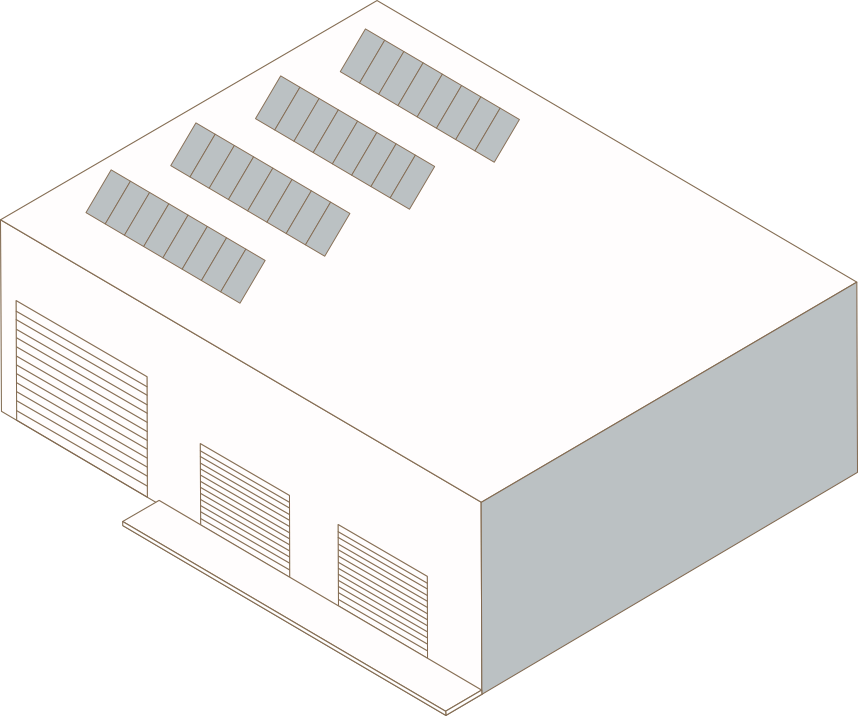
Země
Energie z větších i menších hloubek země přináší výhodu stálé teploty pro vytápění i chlazení domů.
Dají se využít k topení i chlazení, a platí, že čím jsou hlubší, tím jsou stabilnější.
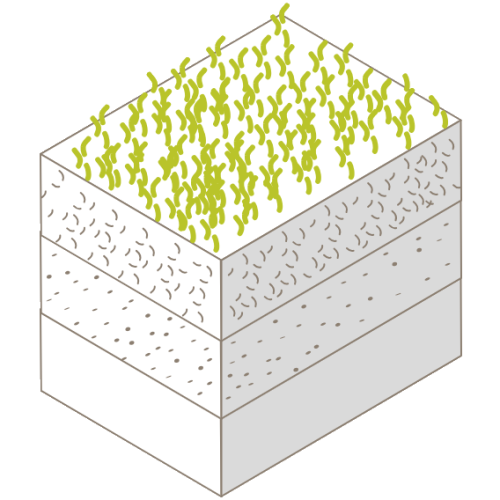
Zajímá vás geotermální energie a její využití?
Geotermální vrty
Geotermální vrty využívají tepelné energie země, kdy za pomoci tepelného výměníku získávájí energii z hloubky 80 až 400 m. Geotermální vrt má výhodu stálého zdroje tepla a je tedy vhodným řešením pro energeticky nezávislé domy (zejména pro nízkoteplotní vytápění a chlazení budov). Současně tato technologie neklade nárok na rozsáhlý pozemek.
Počet a hloubka vrtů pak záleží na několika faktorech:
- plánované spotřebě a velikosti domu,
- kvalitě a vodivosti podloží,
- zda má vrt jeden nebo dva okruhy.
Pro představu: pro rodinný dům (v závislosti na jeho umístění, spotřebě a typu podloží) může stačit i jeden vrt hluboký 150 m.
Princip funkce
Speciální kapalná směs (voda a nemrznoucí kapalina) proudí vrtem, kde ji pohání čerpadlo. Tato kapalina se během toku v okruhu v létě ochladí (nebo v zimě ohřeje) a vrátí se zpět nahoru. Následně pak předá svou teplenou energii a díky principu komprese a expanze je využita k vytápění či chlazení v domě.
Efektivitu vrtu ovlivňuje geologické podloží a kvalita injektážní směsi a celkového provedení.
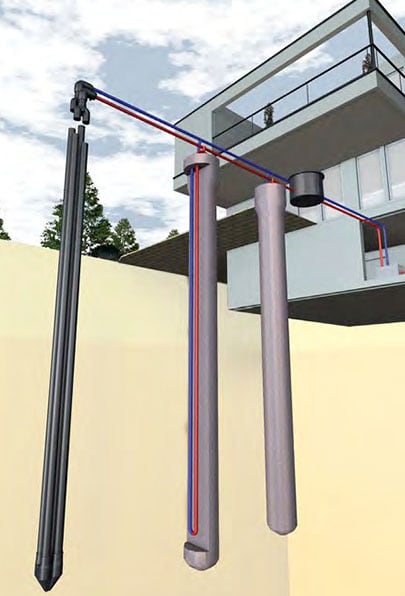
Instalace
Nejprve se provede průzkum podloží, nejčastěji podle hydrogeologických map. Díky tomu je možné určit vlastnosti podloží a účinnost, jakou bude vrt mít, a také spočítat jeho potřebnou hloubku. Následně je také potřeba získat potřebená povolení od úřadů.
V případě realizace se na pozemku vyhloubí vrt (o průměru 15 – 22 cm), což trvá zpravila 1 až 2 dny. Pokud je vrtů více, jejich vzdálenost je zpravidla 1/10 jejich hloubky.
Do vyvrtané štěrbiny je uložena geotermální sonda a okruh se speciální kapalinou, které jsou následně injektážně zality, čímž se teplovodivě spojí s okolní zeminou a horninou. V případě potřeby je možné do vrtu instalovat dva okruhy, díky čemuž je možné vrt zkrátit.
Geotermální vrt je pak propojen s geotermálním tepleným čerpadlem, které získanou energii zužitkuje uvnitř budovy.
Výhody
- vhodné řešení pro energeticky nezávislé domy,
- přísun stálé a neomezené energie z hlubin země, která bohatě vystačí k vytápění domu,
- výkon geotermálního vrtu se pohybuje v rozmezí 10 až 70 W/m, může dosáhnout i 100 W/m,
- stálá teplota je již v hloubce 15 m pod terénem a níže, geotermický gradient je 3 °C/100 m,
- je možné využít energii k vytápění i chlazení (energie se do země prostě vrátí),
- ušetří se prostor na pozemku (vrt je hluboký, ale nezabírá velkou plochu),
- delší životnost – 50+let (je to uzavřený systém, který se nemá jak pokazit),
- k údržbě stačí jednou za několik let vyměnit chladicí kapalinu,
Specifika
- větší počáteční investice (je třeba dopravit na místo vrtnou soupravu a vyhloubit vrt),
- k vrtání je potřeba vyřídit nezbytnou administrativu (se kterou vám rádi pomůžeme), jako je:
- stavební povolení
- ohláška na příslušném úřadě,
- povolení od vodoprávního úřadu,
- pro vrty hlubší než 200 m je třeba posudek vlivu na životní prostředí (EIA),
- nehodí se do oblastí, kde hrozí zemětřesení.
Zajimají vás novinky z oblasti geotermální energie?
Podívejte se na web, který se věnuje výhradně problematice získávání a využití energie ze země:
Mělké vrty – Vertical Thermpipe
Mělký geotermální vrt je řešením pro energeticky nezávislé domy, kdy je nutné omezit hloubku vrtu. Je vhodný pro místa s výskytem spodních vod a současně tato technologie neklade nárok na rozsáhlý pozemek.
Počet a hloubka vrtů pak záleží na několika faktorech:
- plánované spotřebě a velikosti domu,
- kvalitě a vodivosti podloží a výskytu zemních vod.
Princip funkce
Speciální kapalná směs (voda a nemrznoucí kapalina) proudí kolektorem, kde ji pohání čerpadlo. Tato kapalina se během toku v okruhu v létě ochladí (nebo v zimě ohřeje) a vrátí se zpět nahoru. Následně pak předá svou teplenou energii a díky principu komprese a expanze je využita k vytápění či chlazení v domě.
Efektivitu vrtu ovlivňuje především množství proudící podzemní vody.
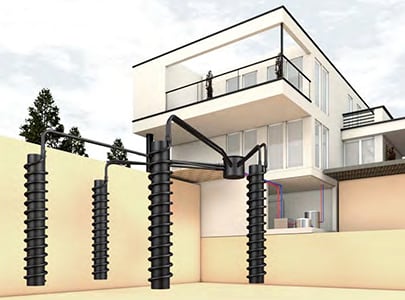
Instalace
Vertical Thermpipe jsou 6 nebo 12 m hluboké prefabrikované prvky, které jsou instalovány do vyvrtané štěrbiny (o průměru 26 nebo 36 cm) pomocí dutého šnekového vrtáku.
Následně je napojen na geotermální tepelné čerpadlo, které získanou energii zužitkuje uvnitř budovy.
Výhody
- vhodné řešení pro energeticky nezávislé domy, kde je nutné omezit hloubku vrtu,
- přísun stálé a neomezené energie z hloubky země, která bohatě vystačí k vytápění domu,
- je možné využít energii k vytápění i chlazení (energie se do země prostě vrátí),
- horizontální potrubí vedoucí k vrtům je uloženo 1 m pod terénem – prostor je pak možné využit pro pěstování rostlin (jediné omezení jsou stromy a rostliny s hlubokými kořeny, případně jiné stavby),
- nezalívá se betonem (jako je tomu u hlubokých vrtů) – jednodušší instalace,
- Vertical Thermpipe prefabrikáty mají tlakovou zkoušku s certifikátem,
- delší životnost – 50+let (je to uzavřený systém, který se nemá jak pokazit).
Specifika
- pokud v místě není spodní voda, nelze realizovat,
- větší počáteční investice (je třeba dopravit na místo vrtnou soupravu a vyhloubit vrty),
- zabírá větší plochu pozemku,
- k vrtání je potřeba vyřídit nezbytnou administrativu (se kterou vám rádi pomůžeme), jako je:
- stavební povolení,
- ohláška na příslušném úřadě,
- povolení od vodoprávního úřadu.
Plošné kolektory pod základovou deskou
U novostaveb, které mají základovou desku v zemi, lze instalovat plošné kolektory přímo do desky jednoduše a i tato hloubka stačí k využití tepelné energie pozemku (s výhodou toho, že je instalován přímo pod domem). Plošné kolektory pod základovou deskou jsou vhodným řešením pro energeticky nezávislé budovy, u kterých je zastavěná plocha shodná s velikostí stavební parcely.
Princip funkce
Speciální kapalná směs (voda a nemrznoucí kapalina) proudí vrtem, kde ji pohání čerpadlo. Tato kapalina se během toku v okruhu v létě ochladí (nebo v zimě ohřeje). Následně pak předá svou teplenou energii a díky principu komprese a expanze je využita k vytápění či chlazení v domě.
Instalace
Do základní desky jsou uloženy horizontální rozvody ve 100 m délkách a následně jsou opět zality betonem. Rozvody jsou naplněny teplonosnou nemrznoucí kapalinou, která cirkuluje mezi kolektorem a tepelným čerpadlem, díky čemuž se přenášejí teplo z půdy pod domem do topného systému domu.
Efektivitu systému ovlivňuje hydrogeologická skladba podloží.
Výhody
- systém je přímo pod domem v jedno základové desce – ušetříte plochu zahrady,
- je možné využívat geotermální energii pro vytápění i chlazení.
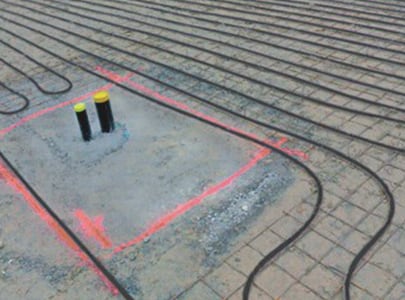
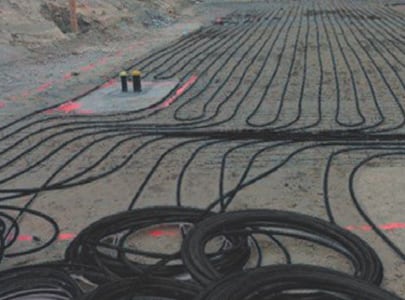
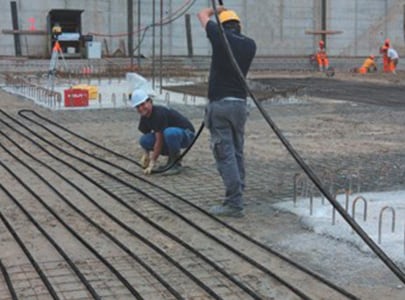
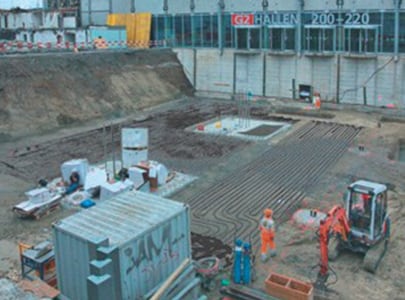
Energopiloty
Energopiloty umožňují využít tepelnou energii vašeho stavebního pozemku pod povrchem terénu u budov, které jsou ze statických důvodů postaveny na základových pilotech. Tento systém dovoluje geotermálně aktivovat jak prefabrikované betonové základové piloty, vrtné a šnekové piloty, tak i piloty betonované přímo na staveništi. Energopiloty pak slouží jako geotermický absorbér pro zásobování teplem a chladem budov přímo z jejich základů.
- Kapacita energopilot v podstatě závisí na průřezu výztužní kostry pilot.
- Energopiloty jsou vhodné pro nízkoteplotní vytápění a chlazení budov.
Princip funkce
Speciální kapalná směs (voda a nemrznoucí kapalina) proudí systémem zalitým v pilotě, kde ji pohání čerpadlo. Tato kapalina se během toku v okruhu v létě ochladí (nebo v zimě ohřeje) a vrátí se zpět. Následně pak předá svou teplenou energii a díky principu komprese a expanze je využita k vytápění či chlazení v domě.
Výhody
- přísun stálé a neomezené energie z hloubky země, která bohatě vystačí k vytápění domu,
- je možné využít energii k vytápění i chlazení (energie se do země prostě vrátí),
- využijí se části budovy a není třeba dalších vrtů na pozemku, mají tak nižší vstupní náklady než u samostatných geotermálních vrtů.
- delší životnost – 50+let (je to uzavřený systém, který se nemá jak pokazit),
- není nutnost geologického průzkumu nebo povolení (je součástí budovy jako takové).
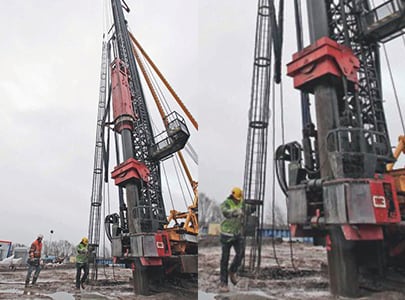
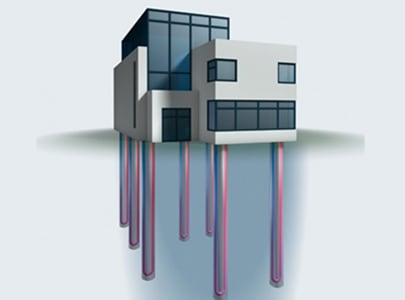
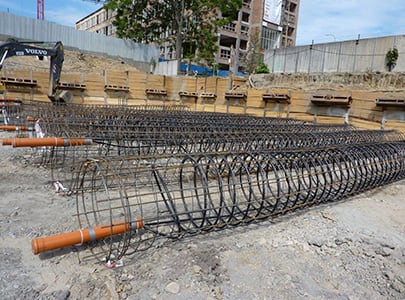
Betonové podzemní konstrukce
Betonové podzemní konstrukce slouží k využití tepelné energie stavebního pozemku u budov, jejichž betonová konstrukce je postavena pod terénem.
Tento systém dovoluje geotermálně aktivovat betonové základové konstrukce, podzemní stěny, nebo milánské zdi. Aktivované betonové konstrukce slouží jako geotermický absorbér pro zásobování budovy teplem a chladem přímo z jejich základů.
Princip funkce a instalace
Tento systém tvoří tepelný výměník integrovaný do stavebních betonových konstrukcí budov, v části kde je betonová konstrukce pod terénem. V principu funguje stejně jako plošné kolektory, jen je zabudován do základové desky – na štěrk a podkladovou betonovou vrstvu se položí kolektory, které se následně pokryjí železobetonovou deskou (to vše dohromady pak tvoří základní desku budovy).
Systém je následně napojen na geotermální tepelné čerpadlo, které získanou energii zužitkuje uvnitř budovy. Energetická kapacita betonových podzemních konstrukcí v podstatě závisí na jejich objemu.
Výhody
- vhodné řešení pro energeticky nezávislé domy, kde je nutné omezit hloubku vrtu,
- přísun stálé a neomezené energie z hloubky země, která bohatě vystačí k vytápění domu,
- nižší vstupní náklady než u samostatných geotermálních vrtů,
- šetří se místo na pozemku,
- není nutnost geologického průzkumu nebo povolení.
Specifika
- budova musí mít základy v podzemní části pod úrovní země (garáže nebo sklepy), jinak není řešení účinné.
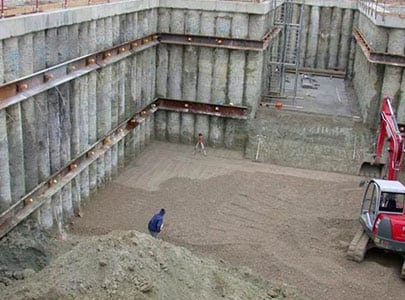
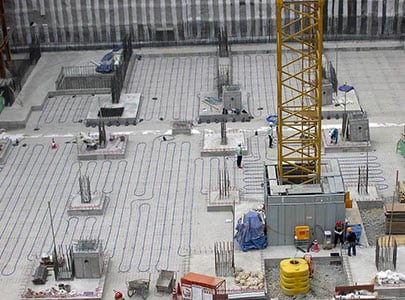
Využití kanalizace PKS Thermpipe
I tepelná energie odpadních vod v kanalizačním potrubí může být užitečný zdroj tepla. Tyto odpadní vody pod povrchem terénu disponují velkým tepelným potenciálem a systém PKS Thermpipe je logickým a ekonomickým řešením, jak tuto energii využít. A protože je teplo současně získáváno i z půdy, která kanalizační potrubí v zemi obklopuje, je to vhodné řešení pro kanalizační sítě nejen energeticky nezávislých domů.
Princip funkce
Kanalizační potrubí je spirálovitě obaleno trubkami, kterými proudí speciální kapalina. Tato kapalina se během toku v okruhu ohřeje/ochladí, předá svou teplenou energii a díky principu komprese a expanze je využita k vytápění či chlazení v domě.
PKS Thermpipe je napojeny na geotermální tepelné čerpadlo, které získanou energii zužitkuje uvnitř budovy. Efektivitu systému ovlivňuje umístění kanalizace, teplota odpadních vod a podíl solárně vyzařující energie.
Výhody
- využívají teplo odpadních vod (jejichž součástí je často velmi teplá voda z vany, sprchy nebo mytí nádobí nejen vašeho domu), které by jinak nebylo využito,
- nezabírá místo na pozemku, přináší další možnosti využití prostoru pod obecní infrastrukutrou,
- dá se realizovat v každém městě i vesnici.
Specifika
- je třeba ho instalovat během položení/výměny potrubí kanalizace.
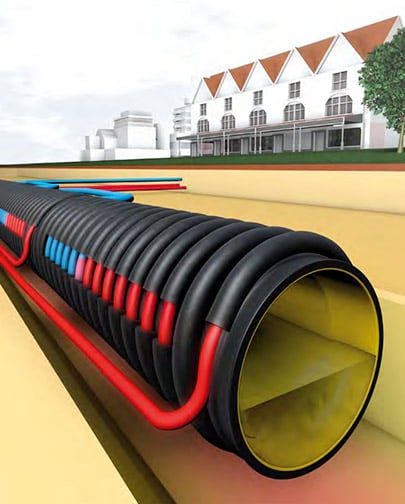
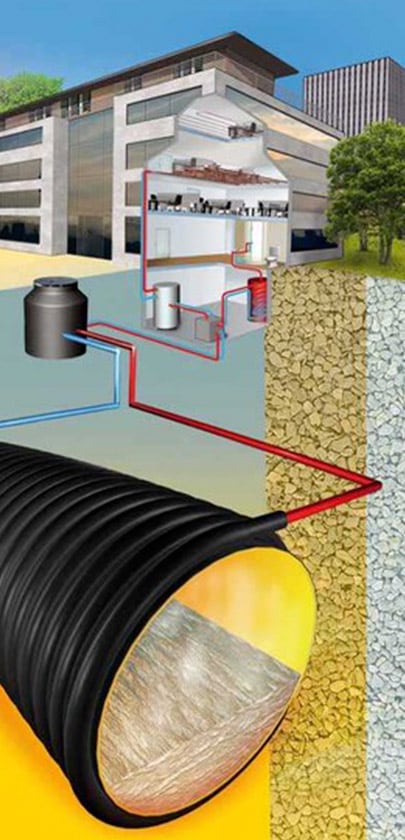
Hybridní systém
Tento systém umožňuje chytře čerpat tepelnou energii ze vzduchu, země, či vody v závislosti na sezónních podmínkách a aktuální efektivitě čerpané energie.
Princip funkce
Principem hybridního systému je možnost výběru z několika zdrojů tepelné energie. Například je možné kombinovat Geotermální vrty s Venkovní vzduchovou jednotkou. Výhodou je ekonomicky využitá geotermální i aerotermální energie v různých ročních obdobích.
Hybridním systémem získáte možnost snížit počet geotermálních vrtů nebo jejich hloubku. Taktéž při nedostatku místa na pozemku pro plošný kolektor může sloužit vzduchová jednotka jako výkonová rezerva.
Plusem tohoto systému je také efektivnější regenerace zemského podloží. V létě je přebytková tepelná energie předávána zpět do země, odkud byla čerpána v zimních měsících.
Tyto systémy jsou propojeny s hybridním tepelným čerpadlem v technické místnosti domu.
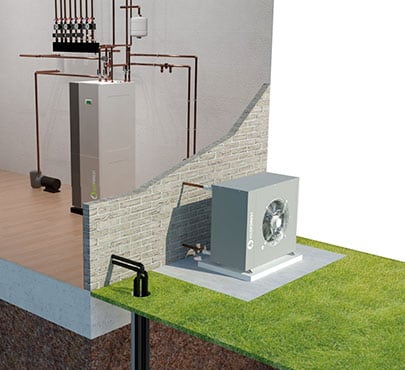
Vzduch
Vzduch jako obnovitelný zdroj je dostupný všude okolo nás a jeho využití za pomoci tepelných čerpadel je velmi efektivní a ekologické a oblíbené díky nízkým provozním nákladům.
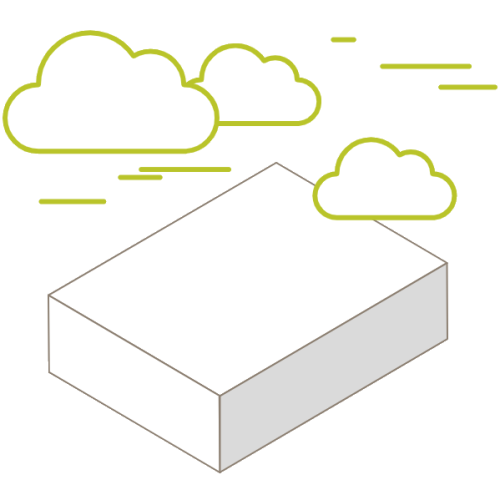
Hybridní systém
Tento systém umožňuje chytře čerpat tepelnou energii ze vzduchu, země, či vody v závislosti na sezónních podmínkách a aktuální efektivitě čerpané energie.
Princip funkce
Principem hybridního systému je možnost výběru z několika zdrojů tepelné energie. Například je možné kombinovat Geotermální vrty s Venkovní vzduchovou jednotkou. Výhodou je ekonomicky využitá geotermální i aerotermální energie v různých ročních obdobích.
Hybridním systémem získáte možnost snížit počet geotermálních vrtů nebo jejich hloubku. Taktéž při nedostatku místa na pozemku pro plošný kolektor může sloužit vzduchová jednotka jako výkonová rezerva.
Plusem tohoto systému je také efektivnější regenerace zemského podloží. V létě je přebytková tepelná energie předávána zpět do země, odkud byla čerpána v zimních měsících.
Tyto systémy jsou propojeny s hybridním tepelným čerpadlem v technické místnosti domu.

Speciální venkovní vzduchová jednotka
Díky své efektivitě a flexibilitě jsou venkovní vzduchové jednotky běžné u moderních domů, kde se využívají pro vytápění nebo chlazení. Jsou napojeny na tepelné čerpadlo, které získanou energii zužitkuje uvnitř budovy.
Princip funkce
Tepelné čerpadlo využívá termodynamické principy k přesunu tepla z jednoho místa na druhé. V případě vytápění v domě odebírá teplo z venkovního vzduchu (v okruhu je chladivo, které absorbuje teplo z okolí, tím se ohřeje a odpaří). Následně je nasáván do kompresoru, který zvýší jeho tlak i teplotu, čímž se chladivo zahřeje a předává získané teplo vnitřní jednotce do vnitřního okruhu. Chladivo se tak ochladí, zkondenzuje a putuje zpět do venkovních prostoru. V případě chlazení je princip opačný.
Výhody
- různé možnosti umístění dle možností – na střeše, fasádě, nebo na pozemku budovy,
- lze ho využít k vytápění i chlazení,
- axiální ventilátor Ziehl-Abegg s vysokou účinností, tichým provozem,
- hydraulické zapojení bez použití chladiva,
- proti klasickým venkovním vzduchovým jednotkám se může pochlubit velmi tichým provozem, vysokou účinností a ventilátorem s řízenou rychlostí otáček,
- kompaktní provedení jednotky a střídmý design,
- patentovaná technologie odmrazování, která zvyšuje koeficient sezónního výkonu, což se projevuje zvýšeným sezónním výkonem,
- součástí je ochrana pro provoz v extrémních povětrnostních podmínkách, což dokazuje i garantovaná funkčnost systému v teplotách -15°C,
- možnost zapojení více jednotek do kaskády,
Specifika
- venkovní vzduchové jednotky jsou závislé na teplotě okolí, není to stabilní zdroj tepla (den/noc, léto/zima),
- potřeba pravidelné údržby,
- účinnost klesá při extrémně nízkých venkovních teplotách.
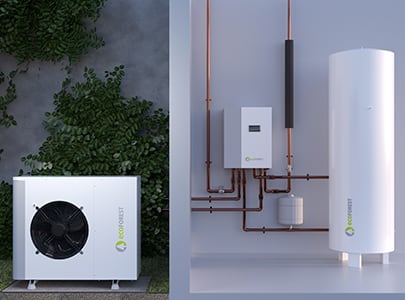
Voda
Voda je dalším z čistých, spolehlivých a stabilních zdrojů energie, díky čemuž jsou účinná a efektivní. V místech s přístupem k povrchové i podzemní vodě je to ideální zdroj tepelné energie.
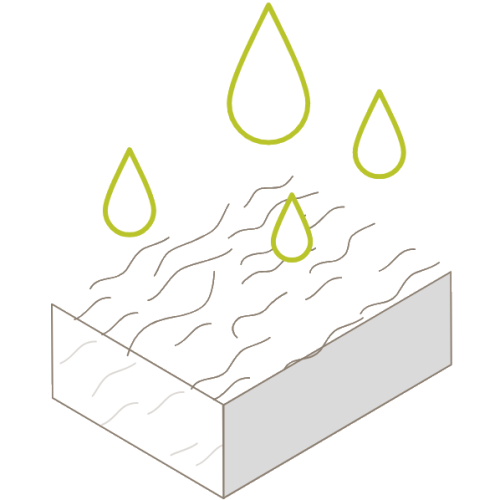
Podzemní vody
Tento systém pro příjem tepelné energie z podzemních vod je vhodným řešením pro energeticky nezávislé domy umístěných na pozemcích bohaté na spodní vody.
Instalace a princip funkce
Tento systém funguje na principu přečerpávání podzemní vody z jedné do druhé studny.
Do vyhloubených vrtů širších průměrů jsou vloženy skruže, opatřené filtračním obsypem a ve vrchní části těsněním. V první studni je umístěné ponorné čerpadlo, které vhání vodu do tepelného čerpadla v technické místnosti domu. Tam je tepelná energie využita a přes druhou studnu se voda vsakuje zpět do země.
Výhody
- možnost využití tepelné energie z vody na místě pozemku,
- teplota spodních vod je celoročně konstantní 7-12°C,
- energii je možné použít na chlazení i vytápění.
Specifika
- instalace podléhá schválení správcem konkrétního vodního zdroje.
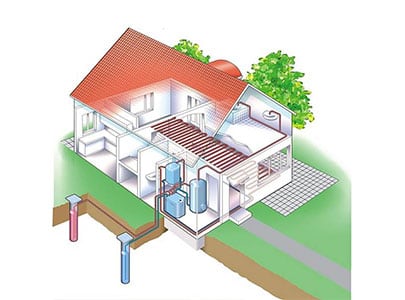
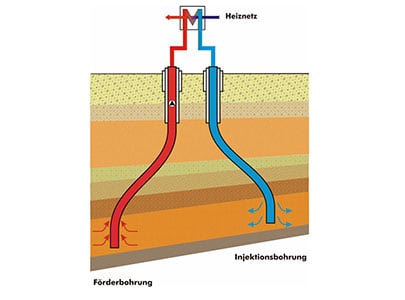
Hybridní systém
Tento systém umožňuje chytře čerpat tepelnou energii ze vzduchu, země, či vody v závislosti na sezónních podmínkách a aktuální efektivitě čerpané energie.
Princip funkce
Principem hybridního systému je možnost výběru z několika zdrojů tepelné energie. Například je možné kombinovat Geotermální vrty s Venkovní vzduchovou jednotkou. Výhodou je ekonomicky využitá geotermální i aerotermální energie v různých ročních obdobích.
Hybridním systémem získáte možnost snížit počet geotermálních vrtů nebo jejich hloubku. Taktéž při nedostatku místa na pozemku pro plošný kolektor může sloužit vzduchová jednotka jako výkonová rezerva.
Plusem tohoto systému je také efektivnější regenerace zemského podloží. V létě je přebytková tepelná energie předávána zpět do země, odkud byla čerpána v zimních měsících.
Tyto systémy jsou propojeny s hybridním tepelným čerpadlem v technické místnosti domu.

Hydrotermální ponorka
Vývoj inovativního modulárního výměníku tepla vzniká ve spolupráci s Technickou univerzitou v Darmstadtu na katedře hydraulického inženýrství a hydrauliky. Nový systém umožňuje využití tepelného potenciálu vody a zároveň její kinetické energie při proudění (např. řeky). Výzkum je financován programem „Centrální inovační program pro malé a střední podniky“.
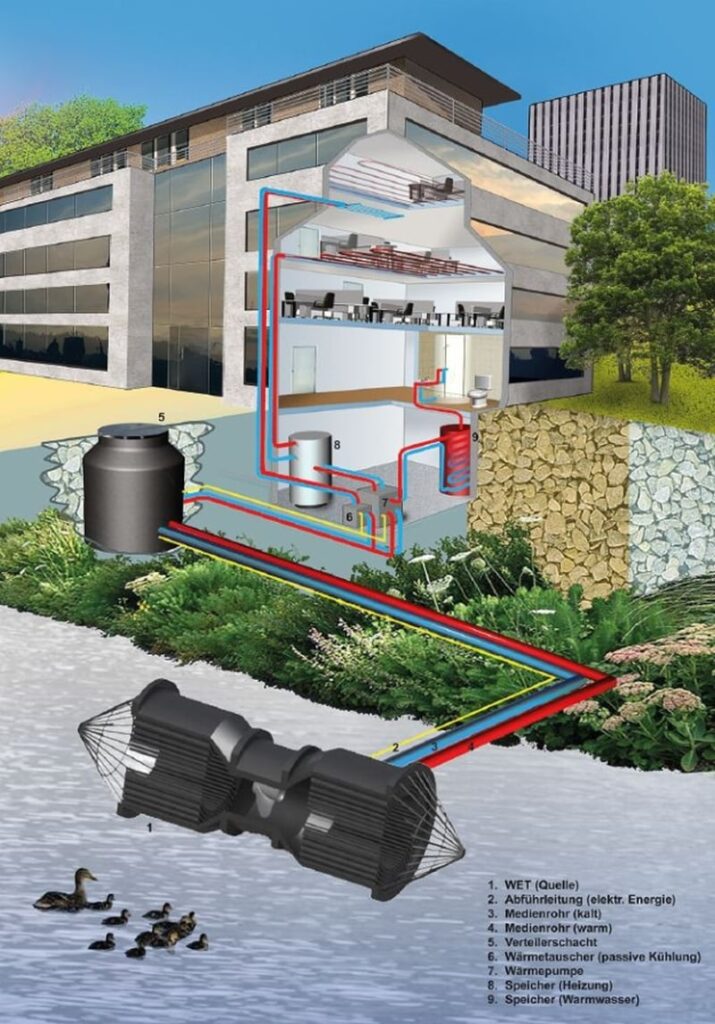
Slunce
Solární energie je také zdroj nevyčerpatelné a dostupné energie, což z ní činí velmi spolehlivý a udržitelný zdroj energie. Využití sluneční energie přispívá k dlouhodobým úsporám na energiích a zvyšuje energetickou nezávislost.
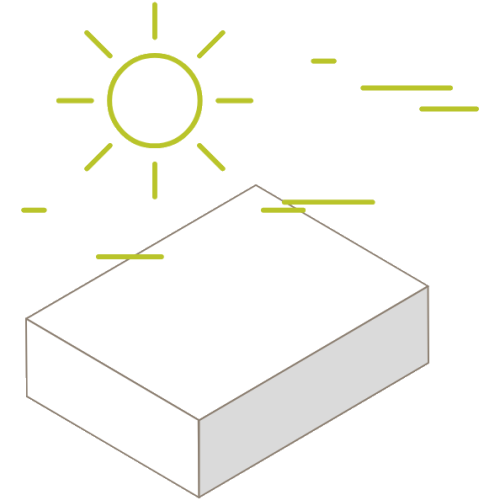
Hybridní fotovoltaické panely
Klasické fotovoltaické panely vyrábí elektřinu, kterou můžeme využít v domě a přebytečnou energii prodat do sítě. Klasické fotovoltaické kolektory ohřívají vodu, kterou lze využít v kuchyni, v koupelně nebo k vytápění. A hybridní fotovoltaické panely spojují funkci obou do jednoho zařízení. Získanou tepelnou energii z panelů je v závislosti na podmínkách možné využít a snížit tak ekonomickou zátěž na provoz domu.
Princip funkce
Hybridní fotovoltaické panely disponují speciálně vyvinutým systémem měděných trubkových meandrů. Hybridní fotovoltaické články jsou chlazeny a panely se nepřehřívají.
Využití energetického potenciálu hybridních fotovoltaických panelů je obdobný jako u solárních kolektorů (např. pro předehřátí teplé vody, přímý ohřev teplé vody a v dalších technologických principech).
Výhody
- vyšší produkcí elektrické energie oproti standardním fotovoltaickým panelům,
- jsou chlazeny a nepřehřívají se.
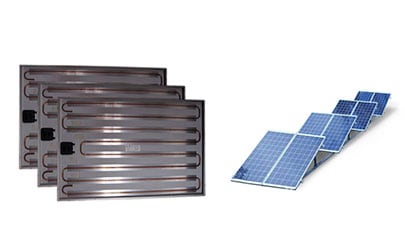
E-System
Tento systém je součástí revoluční chytré sítě, která používá digitální komunikační technologii.
E-Systém v sobě rozšiřuje E-Manager o inverter a vestavěné akumulační baterie.
Princip funkce
Při přebytku elektrické energie z fotovoltaických panelů ukládá E-System vyrobenou elektřinu do baterií. V případě poklesu vlastní výroby elektrické energie je tepelné čerpadlo poháněno uchovanou energií.
E-System je díky modularitě přizpůsobitelný a lze dimenzovat dle výkonových požadavků. Kapacita akumulace je v rozmezí od 2,4 do 9,6 kWh.
Výhody
- vestavěný invertor má také volitelnou funkci EPS (nouzový režim napájení), která umožňuje využít uloženou energii v případě výpadku proudu z elektrické sítě,
- E-System je bezúdržbový a jeho baterie s inteligentním systém dobíjení mají životnost 10 let,
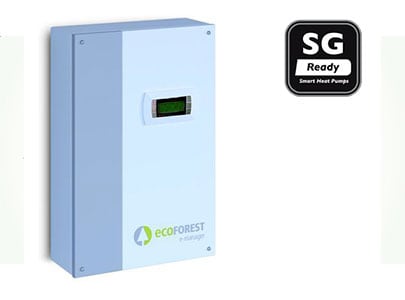
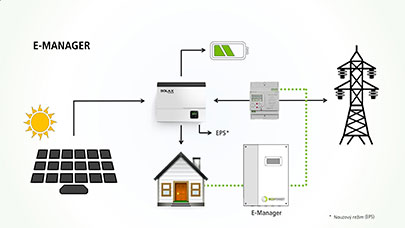
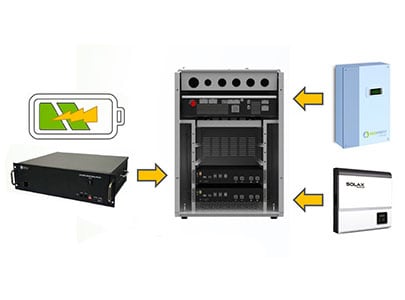
E-Manager
Tento systém je součástí revoluční chytré sítě, která používá digitální komunikační technologii. E-Manager umožňuje nastavit časový plán spotřeby v závislosti na cenách elektrické energie ve špičce, a zároveň v závislosti na ročním období. Tepelné čerpadlo bude vyrábět více tepelné energie v době, kdy je elektřina ze sítě levnější a šetří tak vaše finance. Zároveň se postará o to, že získaná energie bude opravu plně využita (přímé nabíjení zařízení v domě, nabití baterií, ohřev vody…) a teprve přebytkovou energii pošle do sítě.
Princip funkce
E-Manager detekuje přebytky vyrobené elektrické energie z fotovoltaických panelů a reguluje tepelné čerpadlo do optimální rovnováhy mezi spotřebou a produkcí. Když výroba energie z fotovoltaických panelů poklesne, navrací E-Manager tepelné čerpadlo do standardního chodu.
Je možné nastavit limit výkonu tepelného čerpadla. Pokud je úroveň spotřeby blízká nastavené hranici, E-Manager redukuje spotřebu elektrické energie, aby nedošlo k překročení limitu.
Výhody
- ekonomicky využije získanou energii tam, kde je to potřeba,


Hybridní řešení
Hybridní řešení můžete kombinovat výhody několika zdrojů energie uvedených výše a zvýšit tak efektivitu celého topně chladícího systému.
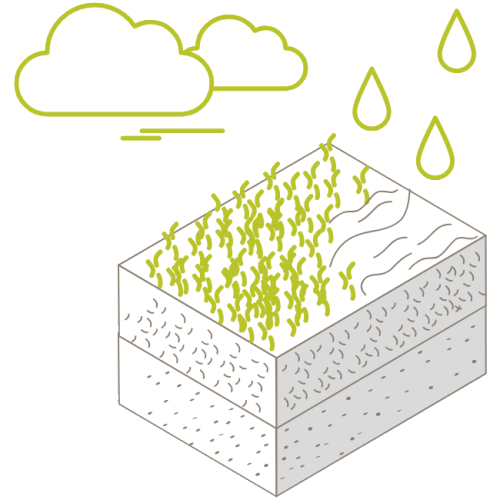
Hybridní systém
Tento systém umožňuje chytře čerpat tepelnou energii ze vzduchu, země, či vody v závislosti na sezónních podmínkách a aktuální efektivitě čerpané energie.
Princip funkce
Principem hybridního systému je možnost výběru z několika zdrojů tepelné energie. Například je možné kombinovat Geotermální vrty s Venkovní vzduchovou jednotkou. Výhodou je ekonomicky využitá geotermální i aerotermální energie v různých ročních obdobích.
Hybridním systémem získáte možnost snížit počet geotermálních vrtů nebo jejich hloubku. Taktéž při nedostatku místa na pozemku pro plošný kolektor může sloužit vzduchová jednotka jako výkonová rezerva.
Plusem tohoto systému je také efektivnější regenerace zemského podloží. V létě je přebytková tepelná energie předávána zpět do země, odkud byla čerpána v zimních měsících.
Tyto systémy jsou propojeny s hybridním tepelným čerpadlem v technické místnosti domu.

Kam dál?
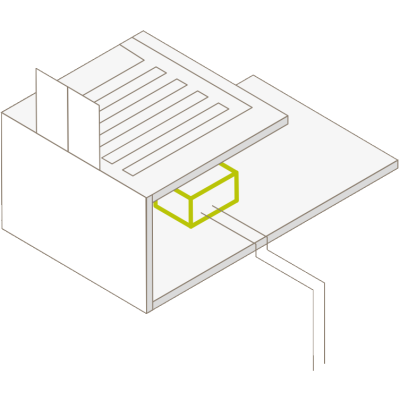
Tepelná čerpadla
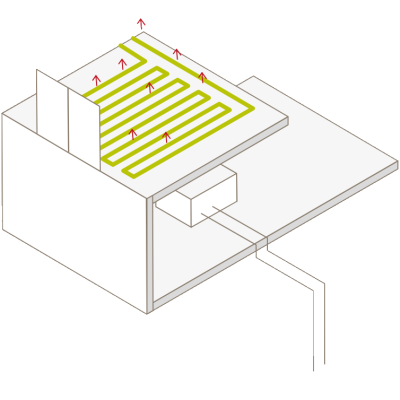
Koncové prvky
Postaráme se o vás
Je na nás spolehnutí
- Vyřídíme za vás vše, od papírů až po realizaci
- 95% realizací jsme nacenili téměř na korunu přesně
- Díky bohatému seznamu dodavatelů vám najdeme to nejlepší řešení
Máte u nás kompletní servis
- Napište nám, jaké řešení by vás přesně zajímalo a jak vypadá budova.
- Spojíme se a zeptáme se vás na další důležité detaily.
- Získáme od dodavatelů návrhy a cenové nabídky.
- Doporučíme vám tu, která je v hodná přesně pro vaši lokalitu.
- Pohlídáme realizaci přímo na místě, aby vše proběhlo podle plánu.
- I po skončení s vámi zůstaváme v kontaktu.
Odpovíte nám na 3 otázky?
Popište nám vaše řešení a my najdeme možnosti, jak uspořit.
